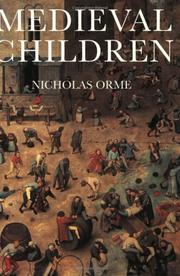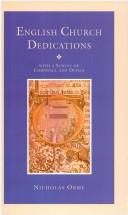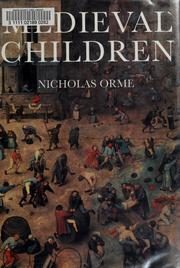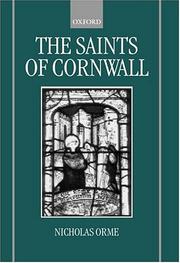| Listing 1 - 10 of 40 | << page >> |
Sort by
|

ISBN: 0416748309 9780416748307 Year: 1984 Publisher: London: Methuen,
Abstract | Keywords | Export | Availability | Bookmark
 Loading...
Loading...Choose an application
- Reference Manager
- EndNote
- RefWorks (Direct export to RefWorks)
History of the United Kingdom and Ireland --- History of education and educational sciences --- anno 1100-1199 --- anno 1200-1499 --- anno 1000-1099 --- Great Britain --- Education of princes --- Education of princesses --- Education, Medieval --- History --- Kings and rulers --- Education --- 798 <09> --- -Aristocracy (Social class) --- -Education of princes --- -Kings and rulers --- Princes --- Aristocracy --- Aristocrats --- Upper class --- Nobility --- Princesses --- Paardrijden--Geschiedenis van ... --- -History --- -Education --- Aristocracy (Social class) --- Education, Medieval. --- History. --- -Paardrijden--Geschiedenis van ... --- -798 <09> --- 798 <09> Paardrijden--Geschiedenis van ... --- Fashionable society --- High society --- Society, High --- Upper classes --- Social classes --- Medieval education --- Seven liberal arts --- Civilization, Medieval --- Learning and scholarship --- Education&delete& --- Paardrijden--Geschiedenis van .. --- Paardrijden--Geschiedenis van --- Education of princes - History - To 1500 --- Education of princes - History - 16th century --- Education of princesses - History --- Great Britain - Kings and rulers - Education - History

ISBN: 0300097549 Year: 2003 Publisher: New Haven London Yale University Press
Abstract | Keywords | Export | Availability | Bookmark
 Loading...
Loading...Choose an application
- Reference Manager
- EndNote
- RefWorks (Direct export to RefWorks)
History of education and educational sciences --- anno 500-1499 --- Social history --- Medieval, 500-1500 --- Children --- England --- History --- Social conditions --- 1066-1485 --- Middle Ages, 500-1500

ISBN: 0300111029 9780300111026 Year: 2006 Publisher: New Haven: Yale university press,
Abstract | Keywords | Export | Availability | Bookmark
 Loading...
Loading...Choose an application
- Reference Manager
- EndNote
- RefWorks (Direct export to RefWorks)
Children have gone to school in England since Roman times. By the end of the middle ages there were hundreds of schools, supporting a highly literate society. This book traces their history from the Romans to the Renaissance, showing how they developed, what they taught, how they were run, and who attended them. Every kind of school is covered, from reading schools in churches and town grammar schools to schools in monasteries and nunneries, business schools, and theological schools. The author also shows how they fitted into a constantly changing world, ending with the impacts of the Renaissance and the Reformation. Medieval schools anticipated nearly all the ideas, practices, and institutions of schooling today. Their remarkable successes in linguistic and literary work, organizational development, teaching large numbers of people shaped the societies that they served. Only by understanding what schools achieved can we fathom the nature of the middle ages.
Schools --- Education, Medieval --- Ecoles --- Education médiévale --- History --- Histoire --- Education médiévale --- Public institutions --- Education --- Public schools --- England --- 16th century --- Education [Medieval ] --- Schools - England - History - 16th century --- Education, Medieval - England

ISBN: 0859895165 9780859895163 Year: 1996 Publisher: Exeter: University of Exeter Press,
Abstract | Keywords | Export | Availability | Bookmark
 Loading...
Loading...Choose an application
- Reference Manager
- EndNote
- RefWorks (Direct export to RefWorks)
Book
ISBN: 1852850035 9781852850036 Year: 1989 Publisher: London: HAMBLEDON,
Abstract | Keywords | Export | Availability | Bookmark
 Loading...
Loading...Choose an application
- Reference Manager
- EndNote
- RefWorks (Direct export to RefWorks)
Education, Medieval --- Renaissance --- Education --- History --- England --- Social conditions --- -Education, Medieval --- -Renaissance --- Revival of letters --- Civilization --- History, Modern --- Civilization, Medieval --- Civilization, Modern --- Humanism --- Middle Ages --- Medieval education --- Seven liberal arts --- Learning and scholarship --- Children --- Education, Primitive --- Education of children --- Human resource development --- Instruction --- Pedagogy --- Schooling --- Students --- Youth --- Mental discipline --- Schools --- Teaching --- Training --- -History --- -Social conditions --- -Education --- -England --- Education, Medieval - England --- Renaissance - England --- Education - England - History - 16th century --- England - Social conditions - 1066-1485 --- England - Social conditions - 16th century

ISBN: 0300085419 Year: 2001 Publisher: New Haven (Conn.) : Yale university press,
Abstract | Keywords | Export | Availability | Bookmark
 Loading...
Loading...Choose an application
- Reference Manager
- EndNote
- RefWorks (Direct export to RefWorks)
Children --- -Social history --- -Descriptive sociology --- Social conditions --- Social history --- History --- Sociology --- Childhood --- Kids (Children) --- Pedology (Child study) --- Youngsters --- Age groups --- Families --- Life cycle, Human --- England --- -Children --- History. --- -History --- Angleterre --- Anglii︠a︡ --- Inghilterra --- Engeland --- Inglaterra --- Anglija
Book
ISBN: 0801464633 1322505497 0801464161 0801477751 0801451027 Year: 2011 Publisher: Cornell University Press
Abstract | Keywords | Export | Availability | Bookmark
 Loading...
Loading...Choose an application
- Reference Manager
- EndNote
- RefWorks (Direct export to RefWorks)
Medieval children lived in a world rich in poetry, from lullabies, nursery rhymes, and songs to riddles, tongue twisters, and nonsensical verses. They read or listened to stories in verse: ballads of Robin Hood, romances, and comic tales. Poems were composed to teach them how to behave, eat at meals, hunt game, and even learn Latin and French. In Fleas, Flies, and Friars, Nicholas Orme, an expert on childhood in the Middle Ages, has gathered a wide variety of children's verse that circulated in England beginning in the 1400s, providing a way for modern readers of all ages to experience the medieval world through the eyes of its children.In his delightful treasury of medieval children's verse, Orme does a masterful job of recovering a lively and largely unknown tradition, preserving the playfulness of the originals while clearly explaining their meaning, significance, or context. Poems written in Latin or French have been translated into English, and Middle English has been modernized. Fleas, Flies, and Friars has five parts. The first two contain short lyrical pieces and fragments, together with excerpts from essays in verse that address childhood or were written for children. The third part presents poems for young people about behavior. The fourth contains three long stories and the fifth brings together verse relating to education and school life.
Children's poetry, Latin (Medieval and modern) --- Children's poetry, French --- Children's poetry, English (Middle) --- Latin children's poetry, Medieval and modern --- Latin poetry, Medieval and modern --- Children's poetry, English --- Children's poetry, Middle English --- English children's poetry, Middle --- Middle English children's poetry --- English poetry --- French children's poetry --- French poetry

ISBN: 9780198207658 0198207654 Year: 2000 Publisher: Oxford: Oxford university press,
Abstract | Keywords | Export | Availability | Bookmark
 Loading...
Loading...Choose an application
- Reference Manager
- EndNote
- RefWorks (Direct export to RefWorks)
Saints --- Cornwall --- Christian saints --- Christian saints, Celtic --- Cornwall (England : County)
Book
Year: 1973 Publisher: London: Methuen,
Abstract | Keywords | Export | Availability | Bookmark
 Loading...
Loading...Choose an application
- Reference Manager
- EndNote
- RefWorks (Direct export to RefWorks)
Book
ISBN: 9781911293354 1911293354 Year: 2018 Publisher: Exeter: Impress Books,
Abstract | Keywords | Export | Availability | Bookmark
 Loading...
Loading...Choose an application
- Reference Manager
- EndNote
- RefWorks (Direct export to RefWorks)
Pilgrimage was popular throughout medieval England until it was suppressed at the Reformation. This book explains how it originated, what it involved, and what it meant to those who practised it. Normally it is imagined in terms of long journeys to famous places in England or Christendom. In fact most pilgrimages were short ones, made to hundreds of nearby shrines and images. This study breaks new ground by exploring the subject through these local journeys and reveals the places that most people visited for most of the time. It shows who went, where and why they went, and what they experienced when they got there. The general study is followed by a detailed survey of the whole of the West of England: from Bristol to the Scillies and back to east Dorset. It lists over 80 sites, ranging from great churches like the cathedrals at Bristol, Exeter, and Wells down to small rural chapels and holy wells. Many of these sites still exist, allowing the book to be used as a guide to places to visit, where one can get a sense of what it was like to be a medieval pilgrim.
Angleterre --- Pèlerinages --- Christian pilgrims and pilgrimages --- Christian shrines --- Great Britain
| Listing 1 - 10 of 40 | << page >> |
Sort by
|

 Search
Search Feedback
Feedback About UniCat
About UniCat  Help
Help News
News